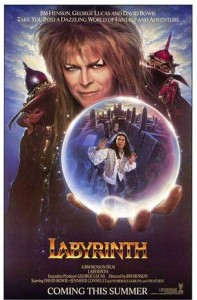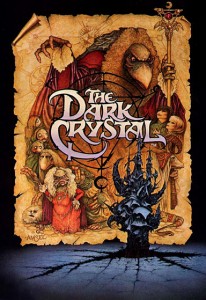
 Some of the greatest fantasy movies in recent memory have come from the incomparable, unbeatable, and sadly never to be repeated collaborations of Jim Henson and Brian Froud. Take the magical madness of Henson’s muppets and the bizarre mythic imagery of Froud’s faeries, throw in some special effects and superb actors, and you get two of the best-loved fantasy movies of the 1980s, Labyrinth and The Dark Crystal.
Some of the greatest fantasy movies in recent memory have come from the incomparable, unbeatable, and sadly never to be repeated collaborations of Jim Henson and Brian Froud. Take the magical madness of Henson’s muppets and the bizarre mythic imagery of Froud’s faeries, throw in some special effects and superb actors, and you get two of the best-loved fantasy movies of the 1980s, Labyrinth and The Dark Crystal.
The Dark Crystal is the earlier collaboration and by far the more ambitious, taking place entirely in a fantasy world created from scratch, and featuring nothing but puppeted characters and special effects. Not a human is to be seen, save for some of the long shots; for the rest, the characters are all puppets, along the same lines as Jim Henson’s muppets. It’s a fairly basic quest story. You know the sort: young character, quite probably the last of his kind, is sent on a desperate quest to save the world, overcome odds, find true love, meet unusual characters along the way, prevail through strength of heart and good looks. That’s not important. What is important is what Henson and Froud and company do with the story in the meantime.
Jen is the last of his kind, one of the fragile, elf-like Gelflings, taken in after his clan was wiped out by the evil Skeksis, and raised by the wise, noble Mystics. He’s been raised in peace and harmony, one with nature, studying under the wisest of the Mystics (who look vaguely like multi-armed turtles after a few too many centuries in the sun). Now, though, the time has come for change. His master lies dying, a thousand years of life finally catching up to him. With his dying words, he urges Jen to go forth into the world, to seek the crystal shard, and to fulfill an ancient prophecy. Baffled, poor Jen indeeds goes forth, and therein lies the tale.
For the Skeksis and Mystics are opposites, and the Skeksis, who rule the castle and take advantage of the Dark Crystal’s power to extend their lifespan and rule their world, have no interest in seeing Jen fulfill his quest. Hey, they wiped out the Gelflings to prevent the prophecy, as we’re informed in the beginning by Joseph O’Conor’s noble, resonant narration (we’re talking James Earl Jones quality for ‘this is the voice of God, and when he speaks, you listen and listen good!’).
As the story progresses, Jen journies through a newly dangerous world, passing beyond the boundaries of the valley in which he was safe. He encounters the cantankerous Aughra, who studies the heavens and knows of the rapidly-approaching Great Conjunction, the time when the three suns will become one, and Jen must heal the Dark Crystal… or let the Skeksis rule the world forever. He wins the crystal shard, and escapes only steps ahead of the Skeksis’ terrifying beetle-like servants, the Garthim.
One renegade scheming Skeksis chamberlain, one female Gelfling raised by the peaceful Podlings, and one yappy toothy ball of fur called Fizzgig later, everything Jen ever thought he knew is in a severe upset. And as the Mystics march towards the inexorable end of all that is, and as the Skeksis come ever closer to eradicating the Gelflings and all threats to their rule, and as Fizzgig tries to bite anything that moves, and as the suns overhead move into place, Jen will be called upon to make the ultimate sacrifice, and to heal the Crystal once and for all. If he fails… well, the Skeksis consider Essence of Gelfling to be a true delicacy.
This is a gorgeous, wonderful movie, made all the more exciting when you look at what the creators accomplished in 1982, compared to today’s standards. The characters move realistically, with a full freedom of motion. The puppeteer aspects are barely noticable. The Gelflings are elven and delicate, the Skeksis twisted and buzzardlike (part predatory bird, part reptile, part dragon), the Mystics ponderous and wise, the Garthim skittery and metallic, and Fizzgig – I want a fizzgig for my very own! Truly, these are classic Froud designs. The landstriders manage to combine the best aspects of camels, giraffes, and god knows what else, for a truly unique feel. There’s nothing on this world that belongs on Earth, giving it that alien, fantastic atmosphere.
I’ve always loved this movie. Henson and Froud combine the best aspects of their respective crafts, along with a wonderfully gifted array of voice actors (such as Percy Edwards for Fizzgig, Stephen Garlick for Jen, Lisa Maxwell for Kira, and Billie Whitelaw for Aughra), and a host of puppeteers and designers, to create something truly special. Now that CGI has become common, and animation has all but replaced humans, it’s easy to look back and scoff at the sometimes awkward puppet effects used in The Dark Crystal, but that’s missing the point. The point is, it was done without animation, without live action, and it came out as a classic. As an added bonus, the video release comes with a documentary about the making of the movie, featuring interviews with various people involved, such as Jim Henson and Brian and Wendy Froud themselves. It’s a great look at how the creators turned images into puppets, and puppets into a movie, and how it took them five years to create a single brilliant film.
There are two movies which forever ingrained Brian Froud’s conceptual genius in my young consciousness, with The Dark Crystal being the first. The second, of course, is the ever-popular Labyrinth, which has become a cult hit over the years, due in no small part to the talented Jennifer Connelly as Sarah, and the unique style of David Bowie as Jareth, the Goblin King. Released in 1986, it forever changed the way many of us looked at the world of Faerie.
This is a coming-of-age story in the same way that The Dark Crystal was a quest story. Sarah, a teenager who prefers to live in a fantasy world called Labyrinth, a world with scripted lines she knows by heart, is sick and tired of being taken for granted by her family, especially where babysitting her baby brother Toby (played by Brian Froud’s son, Toby Froud) is concerned. When she makes a hasty wish upon the power of the goblins, she’s stunned to realize wishes can come true, and they’re not always fair. Jareth, Goblin King and tempter extraordinaire, takes Toby away to the dangerous, seductive, unpredictable world of imagination. In order to fix her mistake, Sarah will be subjected to challenges like none she’s ever experienced. She must travel through, and solve the mysteries of the Labyrinth.
Her enemies: Jareth himself, the goblins he commands, the treacherous nature of the Labyrinth, and time itself with only thirteen hours left before Toby belongs to the Goblin King forever.
Her allies: The unreliable goblin, Hoggle, the diminuative yet noble Sir Didymus (a fox with an attitude) and his sheepdog steed, Ambrosius, and the giant beast with a good heart, Ludo.
Her perils: The goblin armies, the head-juggling Fireys, the riddling door knockers, the mechanical malevolence of the Cleaners, the Bog of Eternal Stench, the illusions cast by the Goblin King, the Junkyard of Lost Treasures.
What’s a girl to do, when the entire world seems to be against her, the rules change midstream, and a cry of “that’s not fair!” gets her no sympathy at all? Why, muddle through, play the game, and grow up along the way. By the time Sarah’s beaten the Labyrinth and come to challenge the Goblin King in the Escheresque twists of his own castle, she’ll have made the hardest decisions of her young life. And no one can do it but her. Not Hoggle, not Ludo, not Didymus. Just Sarah. Jareth will offer her the world, and a world of dreams, and the dream of a world, and all she has to do, in exchange for everything she could ever want, is surrender to his power…. it’s such an easy thing to do. What will she do?
This is such a lovely, fun movie. David Bowie is in his element as the wicked glam-rock King of the Goblins, alternately tempting and terrifying, and even breaking into song. (You ain’t seen anything until you’ve seen him and a few dozen goblins in a rousing rendition of ‘Jump, Baby Jump’.) Jennifer Connelly is dazzling and adorable as Sarah, a teenager placed in the most awkward situations of her life. Toby Froud is… er… cute. (He’s a toddler, whaddya expect?)
Where the movie shines, though, is once again in the magical designs of Brian Froud, and the bizarre genius of Jim Henson. They weave a world of treacherous fairy tale beauty, and populate it with uniquely engaging creatures. They defy description, ranging from the noble, Quixotic fox-knight Didymus, to the twisted inhabitants of the Labyrinth, from the shaggy Ludo to the crochety Hoggle. The Labyrinth is a place just beyond our world, but as strange as any dream, something that wouldn’t be out of place in an Emma Bull or Charles de Lint story. The goblins possess as much personality as any human, and twice as much expression.
Labyrinth is a story about growing up, about responsibility, about imagination and a place for childhood things. It’s about magic and dreams, and about making those hard choices in the end. It’s about “it’s not fair” and “You have no power over me” and the nature of stories reflecting reality. It’s one of those fantasy films that so perfectly fits a niche that it’s become a legend in its own right. As a bonus, the tape release has an added behind-the-scenes documentary.
Lightning may not strike twice in the same place, but magic certainly has, where Henson and Froud are concerned. They gave us two perfect movies together. Those, along with Jim Henson’s The Storyteller TV series, are some of the best fantasy work you’ll see on either big or little screen. I can’t recommend The Dark Crystal or Labyrinth enough. Whether you go for the tape, or DVD, you’ll find that these films are classics for a reason.
